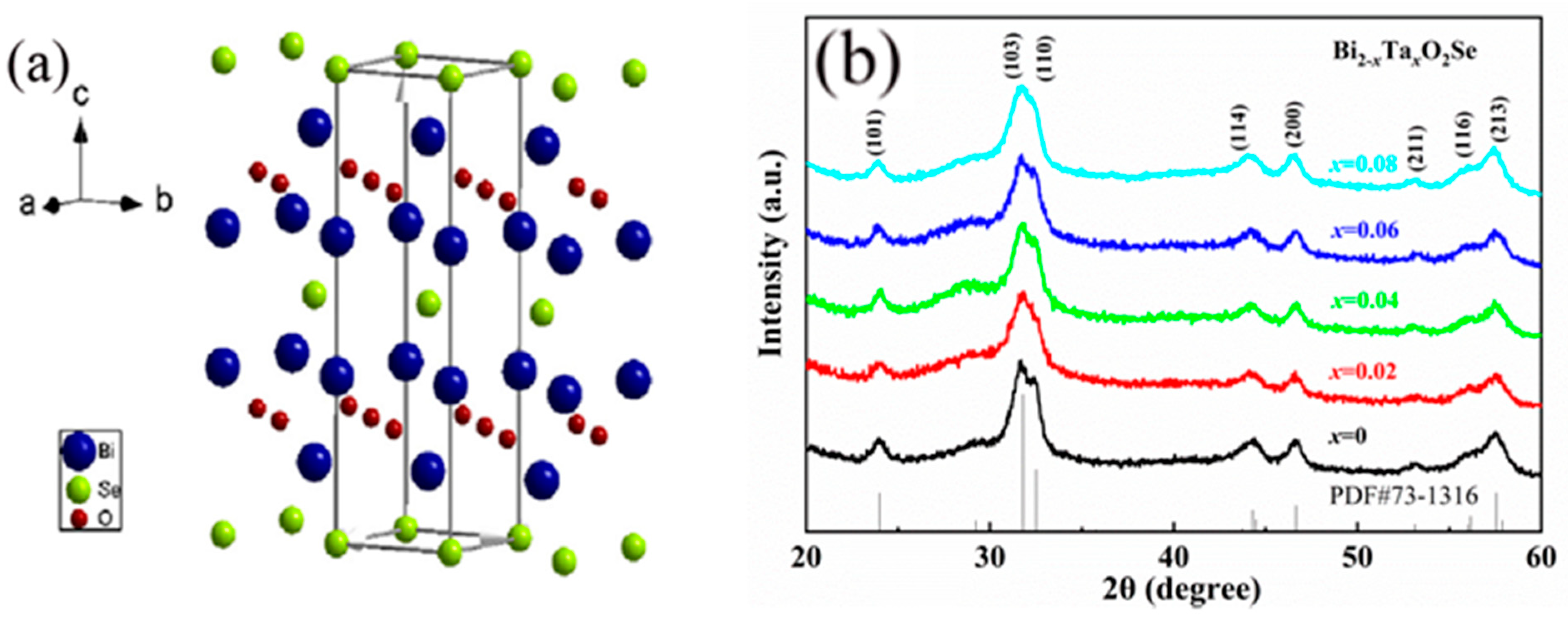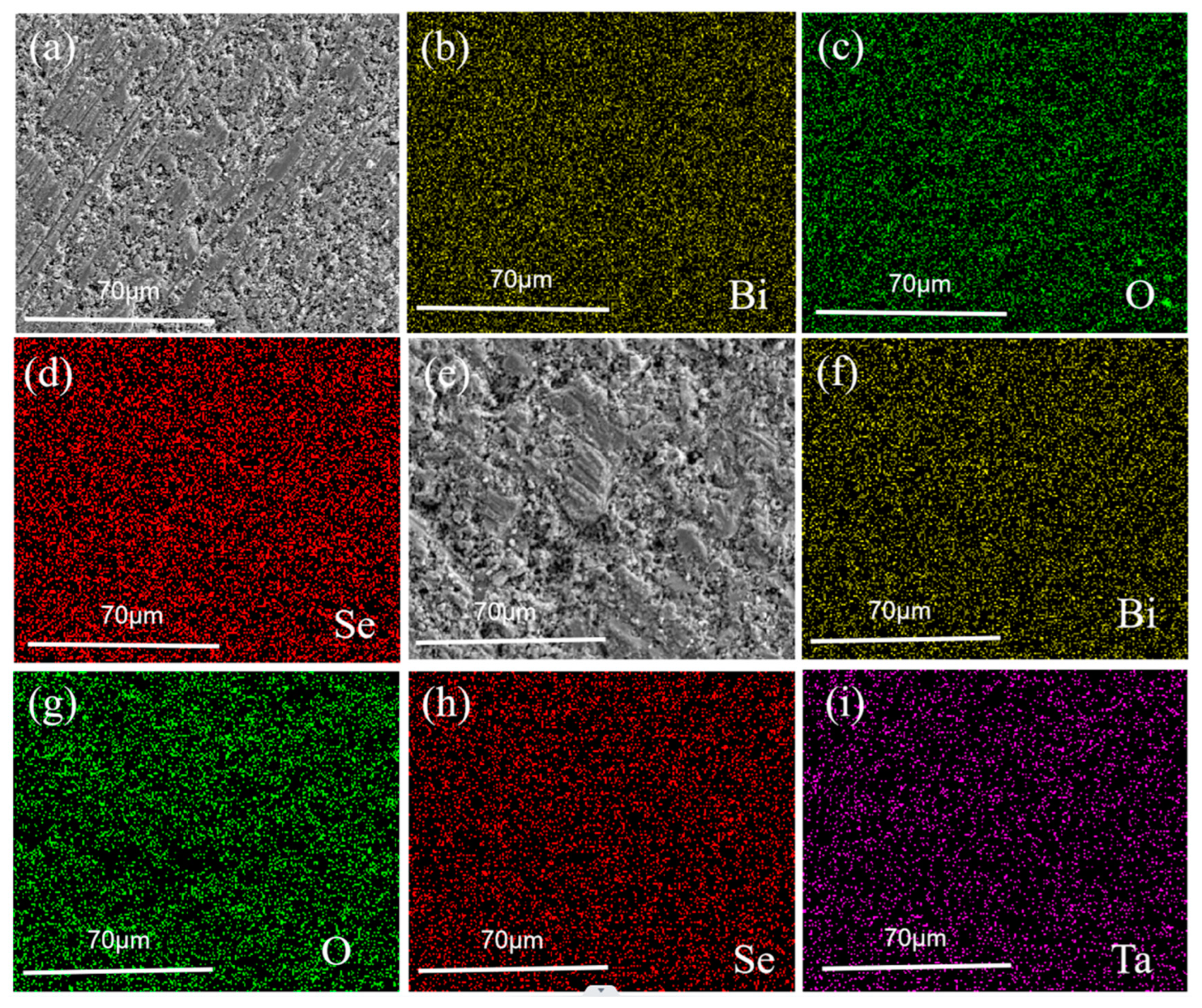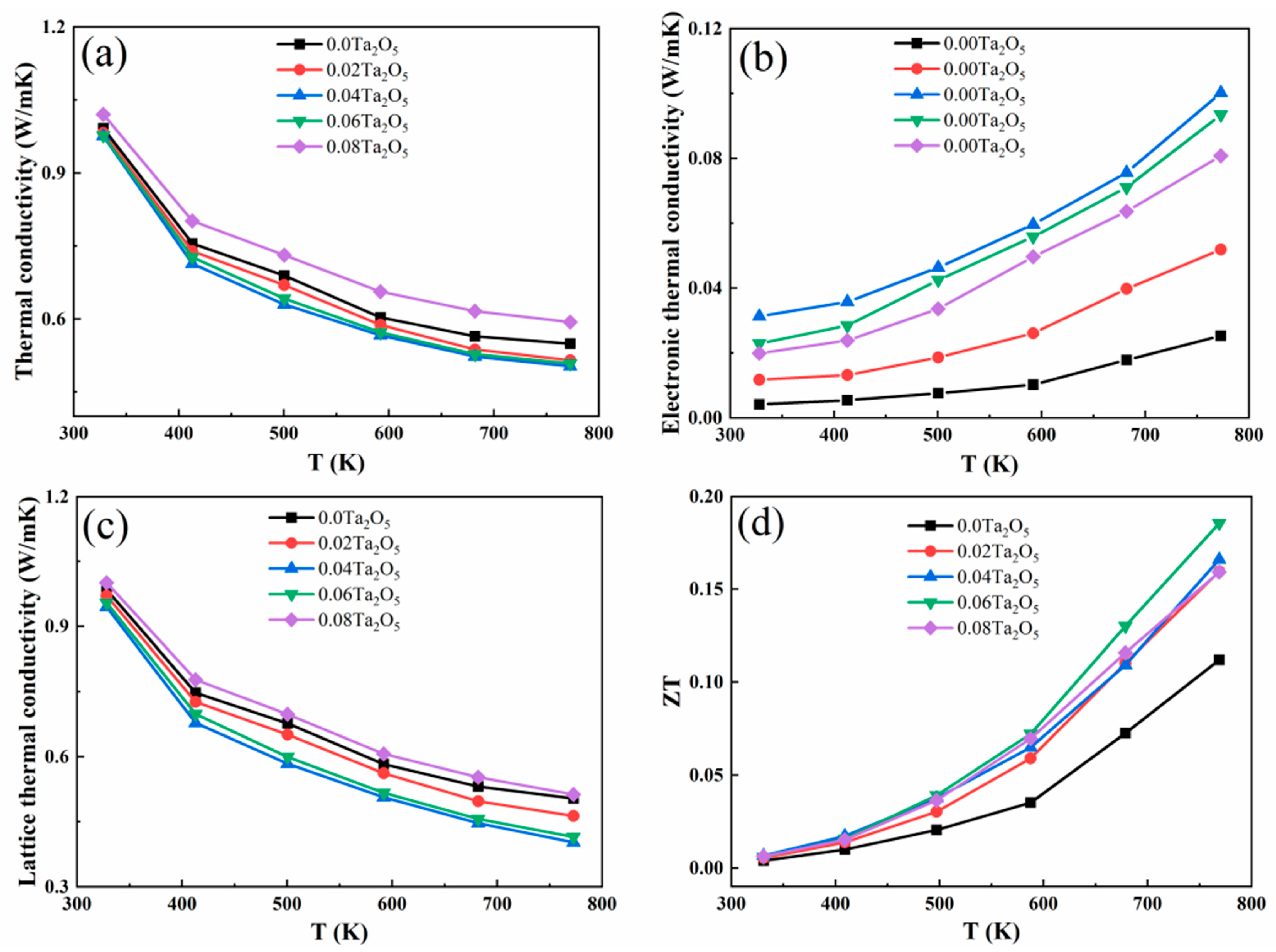Effect of Ta Doping on the Microstructure and Thermoelectric Properties of Bi2O2Se
Abstract
:1. Introduction
2. Experimental
2.1. Sample Preparation
2.2. Characterization
3. Results and Discussion
4. Conclusions
Author Contributions
Funding
Institutional Review Board Statement
Informed Consent Statement
Data Availability Statement
Acknowledgments
Conflicts of Interest
References
- DiSalvo, F.J. Thermoelectric cooling and power generation. Science 1999, 285, 703–706. [Google Scholar] [CrossRef]
- Snyder, G.J.; Toberer, E.S. Complex thermoelectric materials. Nat. Mater. 2008, 7, 105–114. [Google Scholar] [CrossRef] [PubMed] [Green Version]
- Xiao, Y.; Zhao, L.-D. Seeking new, highly effective thermoelectrics. Science 2020, 367, 1196–1197. [Google Scholar] [CrossRef] [PubMed]
- Xiao, C.; Li, Z.; Li, K.; Huang, P.C.; Xie, Y. Decoupling interrelated parameters for designing high performance thermoelectric materials. Acc. Chem. Res. 2014, 47, 1287–1295. [Google Scholar] [CrossRef] [PubMed]
- Beekman, M.; Morelli, D.T.; Nolas, G.S. Better thermoelectrics through glass-like crystals. Nat. Mater. 2015, 14, 1182–1185. [Google Scholar] [CrossRef]
- Tan, G.; Zhao, L.-D.; Kanatzidis, M.G. Rationally designing high-performance bulk thermoelectric materials. Acc. Chem. Res. 2016, 116, 12123–12149. [Google Scholar] [CrossRef]
- Terasaki, I.; Sasago, Y.; Uchinokura, K. Large thermoelectric power in NaCoO4 single crystals. Phys. Rev. B 1997, 56, R12685. [Google Scholar] [CrossRef]
- Ohta, H.; Kim, S.; Mune, Y.; Mizoguchi, T.; Nomura, K.; Ohta, S.; Nomura, T.; Nakanishi, Y.; Ikuhara, Y.; Hirano, M. Giant thermoelectric Seebeck coefficient of a two-dimensional electron gas in SrTiO3. Nat. Mater. 2007, 6, 129–134. [Google Scholar] [CrossRef]
- Dong, S.-T.; Zhang, B.-B.; Zhang, L.-Y.; Chen, Y.; Yao, S.-H.; Zhou, J.; Zhang, S.-T.; Gu, Z.-B.; Chen, Y.-F. Metal-semiconductor-transition observed in Bi2Ca(Sr, Ba)2Co2O8+δ single crystals. Appl. Phys. Lett. 2014, 105, 042105. [Google Scholar] [CrossRef]
- Dong, S.-T.; Zhang, B.-B.; Xiong, Y.; Lv, Y.-Y.; Yao, S.-H.; Chen, Y.B.; Zhou, J.; Zhang, S.-T.; Chen, Y.-F. Anisotropic electrical and thermal conductivity in Bi2AE2Co2O8+δ [AE = Ca, Sr1−xBax (x = 0.0, 0.25, 0.5, 0.75, 1.0)] single crystals. J. Appl. Phys. 2015, 118, 125108. [Google Scholar] [CrossRef]
- Dong, S.-T.; Yu, M.-C.; Fu, Z.; Lv, Y.-Y.; Yao, S.-H.; Chen, Y.B. Technology, High thermoelectric performance of NaF-doped Bi2Ca2Co2Oy ceramic samples. J. Mater. Res. Technol. 2022, 17, 1598–1604. [Google Scholar] [CrossRef]
- Dong, S.-T.; Wei, J.-L.; Yu, M.-C.; Lv, Y.-Y.; Yao, S.-H.; Zhang, B.-B.; Chen, Y.F. Compounds, Anisotropically electrical property of Anderson insulator state in Bi2Ca2-xSrxCo2Oy (x = 0.0, 0.5, 1.0, 1.5, 2.0) single crystals. J. Alloys Compd. 2020, 840, 155450. [Google Scholar] [CrossRef]
- Samarelli, A.; Llin, L.F.; Zhang, Y.; Weaver, J.; Dobson, P.; Cecchi, S.; Chrastina, D.; Isella, G.; Etzelstorfer, T.; Stangl, J. Power factor characterization of Ge/SiGe thermoelectric superlattices at 300 k. J. Electron. Mater. 2013, 42, 1449–1453. [Google Scholar] [CrossRef]
- Pei, Y.; LaLonde, A.; Iwanaga, S.; Snyder, G.J. High thermoelectric figure of merit in heavy hole dominated PbTe. Energy Environ. Sci. 2011, 4, 2085–2089. [Google Scholar] [CrossRef] [Green Version]
- Song, E.; Baranovskiy, A.; Xu, E.; Busani, T.; Swartzentruber, B.; Zhang, S.; Amouyal, Y.; Martinez, J.A. Manipulating thermal and electronic transports in thermoelectric Bi2Te3 nanowires by porphyrin adsorption. AIP Adv. 2018, 8, 105010. [Google Scholar] [CrossRef] [Green Version]
- Ju, H.; Kim, M.; Kim, J. A facile fabrication of n-type Bi2Te3 nanowire/graphene layer-by-layer hybrid structures and their improved thermoelectric performance. Chem. Eng. J. 2015, 275, 102–112. [Google Scholar] [CrossRef]
- Chen, Z.; Jian, Z.; Li, W.; Chang, Y.; Ge, B.; Hanus, R.; Yang, J.; Chen, Y.; Huang, M.; Snyder, G.J. Lattice dislocations enhancing thermoelectric PbTe in addition to band convergence. Adv. Mater. 2017, 29, 1606768. [Google Scholar] [CrossRef] [PubMed]
- Schürmann, U.; Winkler, M.; König, J.D.; Liu, X.; Duppel, V.; Bensch, W.; Böttner, H.; Kienle, L. In Situ TEM investigations on thermoelectric Bi2Te3/Sb2Te3 multilayers. Adv. Eng. Mater. 2012, 14, 139–143. [Google Scholar] [CrossRef]
- Lee, H.; Vashaee, D.; Wang, D.; Dresselhaus, M.S.; Ren, Z.; Chen, G. Effects of nanoscale porosity on thermoelectric properties of SiGe. J. Appl. Phys. 2010, 107, 094308. [Google Scholar] [CrossRef]
- Meng, Q.; Fan, W.; Chen, R.; Munir, Z. compounds, Thermoelectric properties of nanostructured FeSi2 prepared by field-activated and pressure-assisted reactive sintering. J. Alloys Compd. 2010, 492, 303–306. [Google Scholar] [CrossRef]
- Tang, W.X.; Ma, W.Q.; Yu, P.L.; Zhou, Z.F.; Lan, J.L.; Lin, Y.H.; Yang, X.P. Synergistically Optimized Electron and Phonon Transport of p-type BiCuSeO oxyselenides via Pb dopant and Te composite. Mater. Today Phys. 2022, 100898. [Google Scholar] [CrossRef]
- Kim, D.H.; Hong, H.Y.; Park, K. High thermoelectric properties of p-type BiCuSeO co−doped with Ca2+ and Ba2+. J. Alloys Compd. 2021, 876, 159969. [Google Scholar] [CrossRef]
- Kang, H.J.; Zhang, X.Y.; Wang, Y.X.; Li, J.B.; Liu, D.Q.; Chen, Z.N.; Guo, E.Y.; Jiang, X.; Wang, T.M. Enhanced thermoelectric performance of variable-valence element Sm-doped BiCuSeO oxyselenides. Mater. Res. Bull. 2020, 126, 110841. [Google Scholar] [CrossRef]
- He, T.T.; Li, X.T.; Tang, J.; Lou, X.N.; Zuo, X.R.; Zheng, Y.; Zhang, D.W.; Tang, G.D. Boosting thermoelectric performance of BiCuSeO by improving carrier mobility through light element doping and introducing nanostructures. J. Alloys Compd. 2020, 831, 154755. [Google Scholar] [CrossRef]
- Yang, D.; Su, X.; Yan, Y.; Hu, T.; Xie, H.; He, J.; Uher, C.; Kanatzidis, M.G.; Tang, X. Manipulating the combustion wave during self-propagating synthesis for high thermoelectric performance of layered oxychalcogenide Bi1−xPbxCuSeO. Chem. Mater. 2016, 28, 4628–4640. [Google Scholar] [CrossRef]
- Liu, Y.; Zhao, L.D.; Zhu, Y.; Liu, Y.; Li, F.; Yu, M.; Liu, D.B.; Xu, W.; Lin, Y.H.; Nan, C.W. Synergistically optimizing electrical and thermal transport properties of BiCuSeO via a dual-doping approach. Adv. Energy Mater. 2016, 6, 1502423. [Google Scholar] [CrossRef]
- Zhan, B.; Liu, Y.; Tan, X.; Lan, J.; Lin, Y.; Nan, C.W. Enhanced thermoelectric properties of Bi2O2Se ceramics by Bi deficiencies. J. Am. Chem. Soc. 2015, 98, 2465–2469. [Google Scholar]
- Tan, X.; Lan, J.L.; Hu, K.; Xu, B.; Liu, Y.; Zhang, P.; Cao, X.Z.; Zhu, Y.; Xu, W.; Lin, Y.H. Boosting the thermoelectric performance of Bi2O2Se by isovalent doping. J. Am. Chem. Soc. 2018, 101, 4634–4644. [Google Scholar]
- Yang, N.; Pan, L.; Chen, C.; Wang, Y. Compounds, Effects of Sb-doping on the electron-phonon transport properties of Bi2O2Se. J. Alloys Compd. 2021, 858, 157748. [Google Scholar] [CrossRef]
- Zhan, B.; Butt, S.; Liu, Y.; Lan, J.-L.; Nan, C.-W.; Lin, Y.-H. High-temperature thermoelectric behaviors of Sn-doped n-type Bi2O2Se ceramics. J. Electroceram. 2015, 34, 175–179. [Google Scholar] [CrossRef]
- Kim, M.; Park, D.; Kim, J. Enhancement of Bi2O2Se thermoelectric power factor via Nb doping. J. Alloys Compd. 2021, 851, 156905. [Google Scholar] [CrossRef]
- Fu, Z.; Jiang, J.L.; Dong, S.-T.; Yu, M.C.; Zhao, L.J.; Wang, L.; Yao, S.-H. Effects of Zr substitution on structure and thermoelectric properties of Bi2O2Se. J. Mater. Res. Technol. 2022, 21, 640–647. [Google Scholar] [CrossRef]
- Presečnik, M.; Bernik, S. Microstructural and thermoelectric properties of WO3-doped Ca3Co4O9 ceramics. Ceram. Int. 2016, 42, 16103–16108. [Google Scholar] [CrossRef]
- Zhang, X.; Zhang, C.-L.; Lin, S.; Lu, H.; Pei, Y.; Jia, S. Thermoelectric properties of n-type Nb-doped Ag8SnSe6. J. Appl. Phys. 2016, 119, 135101. [Google Scholar] [CrossRef]
- Gong, C.; Shi, Z.; Zhang, Y.; Chen, Y.; Hu, J.; Gou, J.; Qin, M.; Gao, F. Fabrication and thermoelectric properties of Ca-Co-O ceramics with negative Seebeck coefficient. Results Phys. 2018, 9, 1233–1238. [Google Scholar] [CrossRef]
- Tian, Z.; Wang, J.; Yaer, X.; Kang, H.-J.; Wang, X.-H.; Liu, H.-M.; Yang, D.-z.; Wang, T.-M. Pencil painting like preparation for flexible thermoelectric material of high-performance p-type Na1.4Co2O4 and novel n-type NaxCo2O4. J. Mater. 2021, 7, 1153–1160. [Google Scholar] [CrossRef]
- Zide, J.; Bahk, J.-H.; Singh, R.; Zebarjadi, M.; Zeng, G.; Lu, H.; Feser, J.; Xu, D.; Singer, S.; Bian, Z. High efficiency semimetal/semiconductor nanocomposite thermoelectric materials. J. Appl. Phys. 2010, 108, 123702. [Google Scholar] [CrossRef]
- Tan, X.; Liu, Y.; Hu, K.; Ren, G.; Li, Y.; Liu, R.; Lin, Y.H.; Lan, J.L.; Nan, C.W. Synergistically optimizing electrical and thermal transport properties of Bi2O2Se ceramics by Te-substitution. J. Am. Chem. Soc. 2018, 101, 326–333. [Google Scholar]
- Fu, C.; Bai, S.; Liu, Y.; Tang, Y.; Chen, L.; Zhao, X.; Zhu, T. Realizing high figure of merit in heavy-band p-type half-Heusler thermoelectric materials. Nat. Commun. 2015, 6, 8144. [Google Scholar] [CrossRef] [Green Version]
- Feng, B.; Li, G.Q.; Pan, Z.; Hu, X.M.; Liu, P.H.; He, Z.; Li, Y.W.; Fan, X.A. Enhanced thermoelectric properties in BiCuSeO ceramics by Pb/Ni dual doping and 3D modulation doping. J. Solid State Chem. 2019, 271, 1–7. [Google Scholar] [CrossRef]





| Samples | a (Å) | c (Å) | Grain Size (Å) |
|---|---|---|---|
| x = 0 | 3.88317 | 12.20968 | 164 |
| x = 0.02 | 3.88791 | 12.24022 | 157 |
| x = 0.04 | 3.89506 | 12.13847 | 135 |
| x = 0.06 | 3.89414 | 12.21512 | 145 |
| x = 0.08 | 3.90810 | 12.15134 | 171 |
| Samples | n (1018 cm−3) | μ (cm2 V−1 S−1) | m* (m0) | ρ (g/cm3) |
|---|---|---|---|---|
| x = 0 | 1.05 | 30.65 | 0.1814 | 6.967 |
| x = 0.02 | 2.11 | 43.68 | 0.2785 | 7.070 |
| x = 0.04 | 2.73 | 89.52 | 0.3962 | 7.067 |
| x = 0.06 | 3.28 | 54.55 | 0.4031 | 7.036 |
| x = 0.08 | 4.41 | 35.31 | 0.4858 | 7.035 |
Publisher’s Note: MDPI stays neutral with regard to jurisdictional claims in published maps and institutional affiliations. |
© 2022 by the authors. Licensee MDPI, Basel, Switzerland. This article is an open access article distributed under the terms and conditions of the Creative Commons Attribution (CC BY) license (https://creativecommons.org/licenses/by/4.0/).
Share and Cite
Jiang, J.-L.; Dong, S.-T.; Fu, Z.; Yu, M.-C.; Zhao, L.; Wang, L. Effect of Ta Doping on the Microstructure and Thermoelectric Properties of Bi2O2Se. Metals 2022, 12, 1881. https://doi.org/10.3390/met12111881
Jiang J-L, Dong S-T, Fu Z, Yu M-C, Zhao L, Wang L. Effect of Ta Doping on the Microstructure and Thermoelectric Properties of Bi2O2Se. Metals. 2022; 12(11):1881. https://doi.org/10.3390/met12111881
Chicago/Turabian StyleJiang, Jia-Ling, Song-Tao Dong, Zhuang Fu, Miao-Cheng Yu, Lijun Zhao, and Lei Wang. 2022. "Effect of Ta Doping on the Microstructure and Thermoelectric Properties of Bi2O2Se" Metals 12, no. 11: 1881. https://doi.org/10.3390/met12111881





